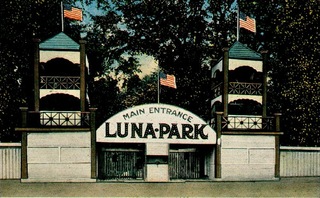 | Back to e-WV
| Back to e-WV
 The West Virginia Encyclopedia
The West Virginia Encyclopedia
 | Back to e-WV
| Back to e-WV
 The West Virginia Encyclopedia
The West Virginia Encyclopedia

Luna Park was built by J. B. Crowley in 1912 on the north bank of the Kanawha River in Charleston. The amusement park occupied seven acres on what had been a three-hole golf course. At present, the park’s site is bordered by the river, Park and Glenwood avenues, Park Drive, and Grant Street.
At the main entrance on Park Avenue stood a large wooden fence with two flag topped spires. Behind the fence, a footbridge led to level ground where park goers could ride the Royal Giant Dips Coaster, a merry-go-round, and a Ferris wheel; play games of chance and skill on the midway; and picnic under shade trees. Other park attractions were a zoo, skating rink, boxing ring, and dance pavilion. Special entertainment included free outdoor movies, hot air balloons, and trapeze artists. People walked to the park or rode streetcars. Excursion boats from Gallipolis and Point Pleasant stopped to let off passengers.
On May 5, 1923, a fire started by welders working on a new swimming pool destroyed most of the park. Although Luna’s owners announced that they would rebuild, the park never reopened. The walkways were eventually paved and houses constructed on the site.
On April 3, 2012, the National Park Service designated 40 acres of Charleston’s West Side, including the area once occupied by Luna Park, as the Luna Park Historic District. Bounded by Kanawha Boulevard, Delaware Avenue, Main Street, and Glenwood Avenue, the district includes nearly 400 homes built between 1910 and 1945. The district also includes Glenwood School, designed by prominent Charleston architect H. Rus Warne.
The original boundary of Luna Park
View it in a larger map
Bing, Louise. Remembering Luna Park. Goldenseal, (Fall 1982).
Wells, Sandy. Rollee Coaster Operator Recalls Luna Park Heyday. Charleston Gazette, 8/6/1985.